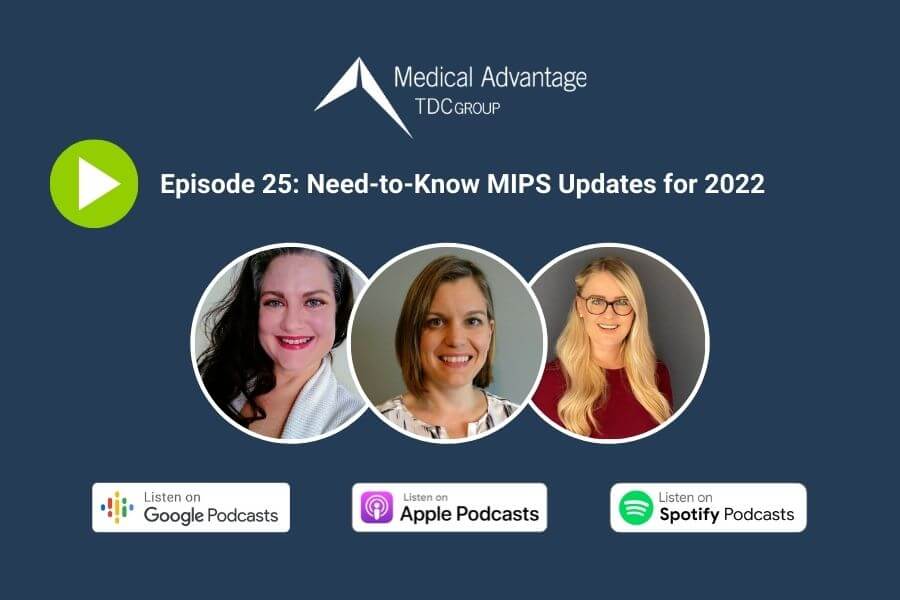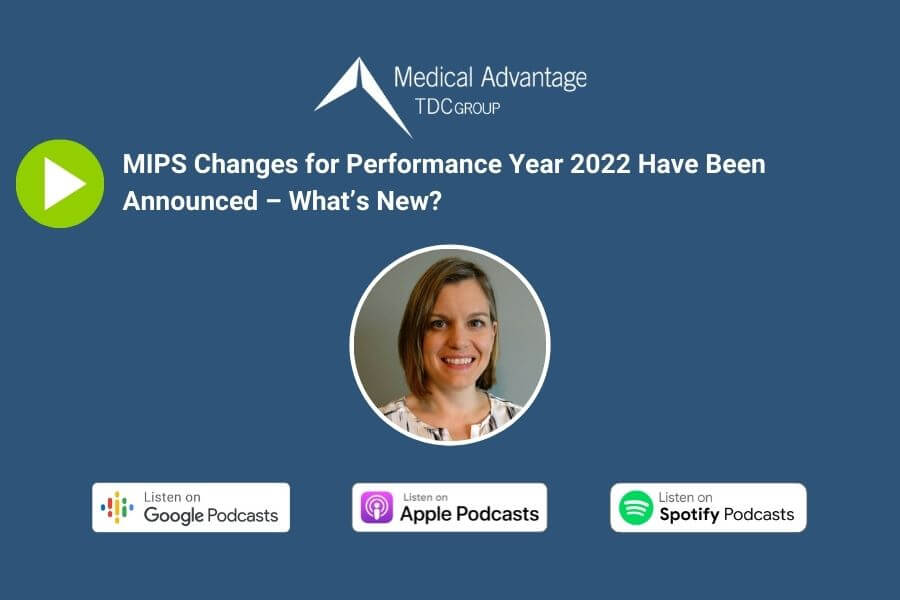Will you get an incentive this year, or will you get a penalty? The best way to juggle these two outcomes is to have a value-based care strategy that will endure the ups and downs of the whole calendar year. To get the best possible outcome from your MIPS performance, we invite you to revisit your 2022 plans and consider where three crucial MIPs updates will have impacted your operations and revenue.
In this episode of the Medical Advantage Podcast hosted by Rebekah Duke, two of our best Quality Consultants specializing in MIPS, Beth Hickerson and Ashley Tuley (both of Medical Advantage) dive into what practices and organizations should know about key changes in MIPS for 2022.
Our goal is to help you form a solid strategy that protects your revenue as you faithfully serve your CMS patient population. In this podcast you’ll learn about:
- The SAFER Guides: Did you know that there are nine guides that enable health care organizations to address EHR safety in a variety of areas, while identifying recommended practices?
- Automatic Hardship Exception for Small Practices: Did you know that starting in 2022 practices will no longer need to submit a hardship application for the PI category? It will be applied automatically, but will this hardship benefit your practice?
- HIE Bi-directional Measure: Most practices struggle with performance on their HIE Measures, which are worth almost half of your PI score. Did you know that your EHR may be able to implement a bi-directional interface, allowing you to obtain the full 40 points, and eliminate the need to report the sending and receiving measures?
Subscribe to the Medical Advantage Podcast
This is the latest episode of the Medical Advantage Podcast, where we take time to delve into the ideas and technologies shaping healthcare, and the best practices your organization can take to stay productive and profitable. Subscribe wherever you get your podcasts to ensure you never miss an episode.
Contact Our Team Today
Episode Transcript for Episode 25: Need-to-Know MIPS Updates for 2022
Intro
Hello and welcome to the Medical Advantage Podcast, where you can hear healthcare professionals, expert consultants, and industry thought leaders discuss the exciting new ideas and technologies that are changing the business of healthcare. Tune into each episode as we hear from some of the most innovative minds in medicine about the future of healthcare and how your organization can stay profitable, efficient, and on top of industry best practices.
Rebekah
Hello and welcome back to the Medical Advantage podcast. I’m Rebecca Duke, your host for today’s episode, all about understanding significant aspects of MIPS in 2022. For those of you new to our podcast and new to us, Medical Advantage is a healthcare services company. We provide a broad portfolio of services for medical practices, specialists, and groups.
Our mission is to simplify the delivery of efficient, high-quality health care. This is done by optimizing performance across any number of operations categories, especially in the case of value-based care arrangements. And this brings us to how MIPS changes in 2022 will impact healthcare.
MIPS of course, being merit-based incentive payment system.
Our consultants have noticed an uptick in requests to help with issues in this particular area, so we wanted to take the time to pursue an understanding so that you can create a smart strategy for your quality measures and reimbursement.
Today I’m pleased to introduce Beth Hickerson and Ashley Tuley, two of our best quality consultants specializing in MIPS. Hello, Beth and Ashley.
Ashley & Beth
Hi Rebekah
Rebekah
Today, Beth and Ashley are going to talk about 3 important updates in the MIPS promoting interoperability category that clinicians and practices should know in order to maximize their performance and their possible incentives. They are going to discuss new requirements that practices conduct an assessment of SAFER guides, the new automatic promoting interoperability, hardship, exception for small practices, and the recently added optional HIE bidirectional exchange measure.
Now before we dive in, Beth, could you give us a general idea of how these changes are expected to impact providers this year?
Beth
Sure, so ultimately these changes will require providers to invest some time on the promoting interoperability category where they may have coasted over the last couple of years. There are some significant changes this year that we’re going to talk about in maximizing performance in MIPS as a whole, and avoiding a penalty will require maximizing performance in each of the individual categories, including promoting interoperability. So additionally, providers may decide that they need to seek some professional consulting help with MIPS this year just to make sure they have everything aligned to the way they need to.
Rebekah
Thank you so much, Beth. Let’s get started with our first update. This SAFER guide. Take it away.
Beth
Sure, so this year in 2022, CMC has implemented a new attestation requirement for the promoting interoperability category, and this requirement requires you to attest – Yes – that you conducted an annual assessment of the high priority guide of the SAFER Guides.
That’s kind of a mouthful, so I’m going to break it down for you.
SAFER and SAFER guides stands for “Safety Assurance Factors for EHR Resilience.”
So the SAFER guides are a collection of nine downloadable, fillable PDF guides available from healthit.gov and they are designed to help healthcare organizations address HR safety in a variety of areas. So for example high priority practices within the group, organizational responsibilities, contingency planning, and more.
There are nine total safer guides, but for this MIPS attestation, your practices are only required to complete the first guide, which is called high priority practices. They’re not required to complete all nine guides.
So just a little bit more background on those SAFER guides in general. Again, I said as I stated, there are nine separate guides, there are a total of 167 standards if a practice wanted to complete all nine guides. Some examples of those standards are for instance designating. Who’s assigned to monitor and maintain hardware and software and network and Internet systems and other is policies and procedures for hardware and software redundancy and contingency planning and another is scheduling regular updates for evidence-based guidelines and order sets within the EHR.
So it’s really, these guides are designed to help practices come up with the plans and the policies and the procedures for making sure that they are using their EHR as efficiently and as optimally as they possibly can.
I like these guides, the SAFER guides that health.gov is put out. I think that it’s a usable tool. The tool itself or the PDF downloads include a page for each one of the standards, and on those pages, there’s room to designate what the status is of the standard for the practice at that time, a place to make notes on what they are currently doing to meet the standard, and maybe what follow up actions need to be taken, a place to delegate those actions and set a deadline.
This gives practices the opportunity to document all of the information that they need to know and are a easy to follow format so it’s easy to follow.
I won’t necessarily say that it’s going to be quick to complete because it’s not similar to the security risk analysis. This will take practices time, especially in the first year that they completed. But every year after that they should just be able to update the guide from the previous year. Practices don’t need to hire a third party to complete the guide but they will likely need to implement a team at their practice to do so because there’s unlikely to be one person at the practice who can answer all of the questions in the guide.
In addition to that, practices should be prepared to potentially consult with their IT service provider or their EHR vendor on some of the standards because they may not necessarily know what the EHR vendor is doing behind the scenes for instance. Maybe to test updates or upgrades before those are released to the practice.
So as I mentioned, practices do need to complete the one high-priority practices guide. If you are a practice, I would encourage you to maybe consider completing all nine guides, or at least more than one guide, because there are some practical advantages to completing the safer guides other than just having to do so for MIPS.
A big one of those is going to be the peace of mind. So if you go through and complete all nine guides, a practice is going to have a great handset for how to handle issues when they inevitably arise. So instead of having 2 problems solve or research on the fly if there’s an issue. So say for instance a practice manager walks into a practice in the morning and immediately is told that the EHR is down. There doesn’t have to be any scrambling to figure out what to do next. The guides are a resource and say and lay out the entire procedure for what should happen at that point. So I think it’s a great idea for practices to complete those guides.
Again, I do want to just reiterate that you don’t have to do all nine, just the first one. The high-priority practice is the only one that’s guaranteed.
Ashley
Beth, there was a lot of great information and just to build upon what you said, I feel like even though this topic doesn’t apply to practices to complete all nine as you said and they don’t technically have to do them. I think this is a great opportunity for the practices.
It’s in their best interest to use this year as a test or trial year to work out those kinks with all of those guides and re-evaluate how they’re going to implement for 2023.
Beth
Thanks, Ashley, and that’s a really good point. I had neglected to mention that technically failing to attest, yes, or attesting no to this requirement in 2022 will not impact a provider score in promoting interoperability, but starting in 2023, if a provider were to attest, no, they would not score any points at all in the category, so that’s a really important observation to make. I think 2022 is the year to give it a try and see how things go as a kind of tester year.
I’m going to pass it over to you Ashley to talk about our second topic automatic hardship exception for small practices.
Ashley
Alright well thanks Beth and so as you just mentioned, we’ll go ahead and discuss our next topic, which is the automatic hardship exception for small practices.
So in previous years, the PI hardship has been available to small practices and you’ve been able to take this hardship by logging into the QPP portal and actively applying for the hardship. However, it’s important to weigh your options and not assume that this is the best route for you, as it has been historically.
In previous years, many practices have performed better in quality than PI, but for this year and going forward you need to keep in mind that the available bonus point potential for the quality category has been reduced drastically from 18 to just six points for small practices. So this can greatly affect and impact your overall quality category score, which in turn means that you’re not always going to score better in quality over PI, as you may have done historically.
So if you decide that submitting your PI is in your best interest, you can simply override the automatic exception by submitting your data. But with that being said, if your EHR or registry, the vendor typically submits data on your behalf you need to make sure that you communicate what your intent is for that year, whether it’s to submit your data or accept the hardship because once the data is submitted, there’s no way to undo that submission. So once the hardship is overwritten, there’s no going back.
So Beth with that second topic being addressed, I’ll go ahead and pass it back to you.
Beth
OK, thanks Ashley, and this third topic does apply a little bit to whether or not a practice may decide that they do or do not want to report promoting interoperability. So this last change that we have is something that changed in 2021, but as we’ve been meeting with clients, we find especially new clients, we’re finding that a lot of them don’t know that this measure this new optional measure exists, so starting in 2021 seems introduced a new optional measure called the Health information exchange or HIE bi-directional measure.
This measure falls under the Health Information exchange objective, along with the other two measures in that objective, which are called “support electronic referral loops by sending health information” and “support electronic referral loops by receiving and reconciling health information.”
So this optional measure is designed to be an alternative to those other two measures. If you report the new bidirectional exchange measure, you don’t have to report the referral loop measures.
Before I talk a little bit about the bidirectional exchange measure and describe it to you and how you would meet it, I do want to kind of mention a distinction in terminology here. As we’ve been working with clients, we notice that they are getting a bit hung up or confused on this term Health information technology because CMS is using it in two different ways. In all the literature and the naming of the objectives and the naming of the measures.
So HIE can be defined as a verb in the sense that it is the electronic transmission of healthcare-related data among medical providers, but it can also be defined as a noun, meaning that it is a technology solution that enables providers to share health, electronic health information between data systems.
So in the terms of the name of the objective as a whole which is health information exchange, CMS is using that term in the way of the verb, meaning just the general transmission of data.
But in terms of this new bilateral exchange measure, they are using the term HIE as a noun, so they are specifically relating to a health information exchange, which is an organization or an entity or a network or a framework-specific specifically designed to facilitate the transition, so hopefully, that helps clear up some of the confusion in this in this category.
So to go back to the measure to describe it just a little bit. This measure is an attestation measure, which means that you don’t report a numerator or denominator. You only report either a yes or a no, and you have to answer 3 statements. I won’t read them in full but I’ll give you the gist of them just so you understand what they are.
So the first is I participate in an HIE to enable secure bidirectional exchange, the second statement is the HIE that I participate in is capable of exchanging information across a broad network of unaffiliated exchange partners. And the third is I use the functions of certified EHR to support bidirectional exchange with an HIE. So you have to attest yes to all three of those questions to be able to use this measure. The good news is that if a provider or group can answer yes to all three of those questions they earn 40 points automatically. This is a really large chunk of points because there are 100 points total in the promoting interoperability categories, so this if you’re able to use it, will account for nearly half of your points right there.
This is in contrast to the other two measures, so the referral loop measures are each worth 20 points apiece, and what I see usually with practices is that they don’t perform very well on those measures, and those are performance-based measure performance-based measures, so they only get a percentage of the 20 points for each measure based on the numerator and denominator that they report. Often in EHR’s the whole workflow and documentation for these measures can be complicated or onerous, and sometimes it they just don’t work smoothly at all, so we’re not seeing providers score well on those referral loop measures. This means they’re not scoring many of those totals of 40 points that they could get from those two individual measures so this is a great way to boost promoting interoperability score if you can get that full chunk of 40 points just by attesting yes here.
Aside from that scoring boost, there are also a couple of practical benefits for practices that implement this. First of all, practices will be able to contribute then to the advancement of interoperability in general, and that’s, of course where we’re headed in the big picture, the ability for providers and patients to have access to patient information anytime from anywhere. So if a practice is contributing to a health information exchange network, then they are promoting that interoperability on a bigger picture, which is good for everyone.
Second, having access to an HIE is very well could make life easier for providers and support staff, because rather than reaching out one to one to other providers to get copies of records, they can potentially go to this one source to this health information exchange, which will likely be integrated right directly with the EHR to access the information that they need, which could be a lot quicker and easier than the way we’ve traditionally done it.
The big question when practices find out about this is always how do I meet this measure? How do I attest to this measure so I can get these points? And really, the answer to that lies in the capability of your practices EHR. So can the practice or the HR that practice uses to support the bilateral exchange measure.
The good news is that there are a lot of features that can, they don’t necessarily advertise it, and they don’t do a lot of proactive education with practices to let them know that the measure exists or that they can meet it, but they do have the capability. So some EHR’s that I know of that theoretically can support this measure are Epic, Cerner, Nexgen, eClinicalworks, Athena, Allscripts, and Greenway. That’s just to name a few, and obviously, that’s not an exhaustive list.
I’ve just seen some of the bigger EHR vendors out there and I do say that they can theoretically meet the measure just because the functionality may be dependent on the version of the EHR you have or the whether or not you have certain updates or upgrades in place, so every practice will need to check with their EHR vendor to find out specifically if it’s available for them.
Ashley
A quick comment on that list, so if a practices EHR doesn’t currently support the optional measure, I think it’s a really good idea for them to consider submitting an enhancement request through their EHR vendor in support of adding the functionality to satisfy this measure.
I think we’ve seen a lot of practices do that in the past, and it’s motivated the EHR to make a change that will benefit the clients, especially when it comes to a program like this.
Beth
Agreed, that’s a great point Ashley, thanks.
Rebekah
Thank you so much, Beth and Ashley. So much great information here. Ashley, would you be able to distill this guidance down into actionable steps that our listeners can take perhaps today to get started.
Ashley
Of course, and so for the SAFER guides you can visit the healthit.gov website and you simply search the term SAFER guides. The 1st result will take you to the official page on this topic and then it also will include a 6-minute video overview to help you start learning more about the safer guides.
Next, for the automatic exception for promoting interoperability for small practices, we’re encouraging practices to run their PII report from their HR, at least for the last 90 days, and just gauge where their current performance is. Specifically, we’d suggest that they pay particular attention to the patient electronic access measure because it’s worth 40 points, which is almost half of that category score.
Most practices can score at least a 90% on that measure if they train or retrain their staff on proper workflows. Which they can obtain from their EHR, or if they’re not positive that they’re the most updated.
And lastly, for the HIE bidirectional measure that Beth I just touched on, as we said, you can submit a ticket to the EHR vendor and ask if they’re able to support the attestation for the measure. In 2022, if that answer is yes, then just simply ask them for guidance on how to activate this feature and how to move forward with that functionality.
Rebekah
OK, that brings us to our time today, thank you so much Beth and Ashley for helping us all better understand these important MIPS changes for our audience. Thank you for joining us today. We hope you found this session helpful and we hope you’ll join us again for the next episode.
Outro
Thanks for joining us this week on the Medical Advantage Podcast where we discuss the ideas and technologies changing healthcare and what they mean to your organization. For more information, visit us at medicaladvantage.com and make sure to subscribe to the podcast on iTunes, Spotify, or wherever you get your podcasts so you never miss a show.








